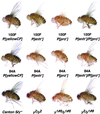Enhancer action in trans is permitted throughout the Drosophila genome
- PMID: 11904429
- PMCID: PMC122591
- DOI: 10.1073/pnas.062447999
Enhancer action in trans is permitted throughout the Drosophila genome
Abstract
Interactions between paired homologous genes can lead to changes in gene expression. Such trans-regulatory effects exemplify transvection and are displayed by many genes in Drosophila, in which homologous chromosomes are paired somatically. Transvection involving the yellow cuticle pigmentation gene can occur by at least two mechanisms, one involving the trans-action of enhancers on a paired promoter and a second involving pairing-mediated bypass of a chromatin insulator. A system was developed to evaluate whether the action of the yellow enhancers in trans could be reconstituted outside of the natural near telomeric location of the yellow gene. To this end, transgenic flies were generated that carried a yellow gene modified by the inclusion of strategically placed recognition sites for the Cre and FLP recombinases. Independent action of the recombinases produced a pair of derivative alleles, one enhancerless and the other promoterless, at each transgene location. Transvection between the derivatives was assessed by the degree of interallelic complementation. Complementation was observed at all eight sites tested. These studies demonstrate that yellow transvection can occur at multiple genomic locations and indicate that the Drosophila genome generally is permissive to enhancer action in trans.
Figures



Similar articles
-
Transvection in Drosophila: trans-interaction between yellow enhancers and promoter is strongly suppressed by a cis-promoter only in certain genomic regions.Chromosoma. 2017 Jun;126(3):431-441. doi: 10.1007/s00412-016-0605-6. Epub 2016 Jun 14. Chromosoma. 2017. PMID: 27300555
-
Two modes of transvection: enhancer action in trans and bypass of a chromatin insulator in cis.Proc Natl Acad Sci U S A. 1998 Sep 1;95(18):10740-5. doi: 10.1073/pnas.95.18.10740. Proc Natl Acad Sci U S A. 1998. PMID: 9724774 Free PMC article.
-
Enhancer blocking and transvection at the Drosophila apterous locus.Genetics. 2008 Jan;178(1):127-43. doi: 10.1534/genetics.107.077768. Genetics. 2008. PMID: 18202363 Free PMC article.
-
Transvection in Drosophila.Adv Genet. 2002;46:399-420. doi: 10.1016/s0065-2660(02)46014-2. Adv Genet. 2002. PMID: 11931232 Review.
-
Chromatin insulators and long-distance interactions in Drosophila.FEBS Lett. 2014 Jan 3;588(1):8-14. doi: 10.1016/j.febslet.2013.10.039. Epub 2013 Nov 5. FEBS Lett. 2014. PMID: 24211836 Review.
Cited by
-
A new method of deleting a specified sequence in transgenic lines of Drosophila melanogaster.Dokl Biochem Biophys. 2005 Sep-Oct;404:342-4. doi: 10.1007/s10628-005-0109-4. Dokl Biochem Biophys. 2005. PMID: 16392752 No abstract available.
-
Determinants of Chromosome Architecture: Insulator Pairing in cis and in trans.PLoS Genet. 2016 Feb 24;12(2):e1005889. doi: 10.1371/journal.pgen.1005889. eCollection 2016 Feb. PLoS Genet. 2016. PMID: 26910731 Free PMC article.
-
An egg apparatus-specific enhancer of Arabidopsis, identified by enhancer detection.Plant Physiol. 2005 Nov;139(3):1421-32. doi: 10.1104/pp.105.068262. Epub 2005 Oct 28. Plant Physiol. 2005. PMID: 16258010 Free PMC article.
-
An Organizational Hub of Developmentally Regulated Chromatin Loops in the Drosophila Antennapedia Complex.Mol Cell Biol. 2015 Dec;35(23):4018-29. doi: 10.1128/MCB.00663-15. Epub 2015 Sep 21. Mol Cell Biol. 2015. PMID: 26391952 Free PMC article.
-
Transvection.Curr Biol. 2017 Oct 9;27(19):R1047-R1049. doi: 10.1016/j.cub.2017.08.001. Curr Biol. 2017. PMID: 29017034 Free PMC article.
References
Publication types
MeSH terms
Substances
Grants and funding
LinkOut - more resources
Full Text Sources
Other Literature Sources
Molecular Biology Databases

